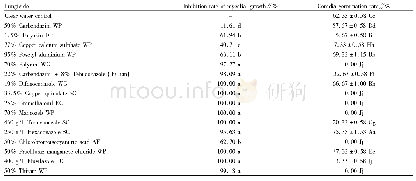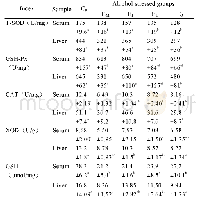《Table 1.Law of the fluid-thickness effect on bubbles and spikes.》
 提示:宽带有限、当前游客访问压缩模式
提示:宽带有限、当前游客访问压缩模式
本系列图表出处文件名:随高清版一同展现
《Finite-thickness effect of the fluids on bubbles and spikes in Richtmyer–Meshkov instability for arbitrary Atwood numbers》
In order to validate the finite-thickness effect,theory results are compared with the numerical simulation.For the two dimensional Euler equations of inviscid and compressible fluid dynamics,fifth-order finite difference WENO schemes with the third-order Runge–Kutta time discretization are used.In our numerical simulation,we set up the problem as follows:the computational domain is[0,0.25]?×?[0,2];the location of the initial shock is at y?=?0.01,and after the shock,the gas density isρ0?=?0.2,the velocity in the x-direction is u?=?0,the one in the positive y-direction is v?=?2.700 31 and the pressure is p?=?3.5.The shock with Mach number 1.0 moves in the positive y-direction,and goes successively through the gas with densityρ1?=?0.1,the fluids with densitiesρ2?=?2.0 andρ3?=?3.0,and the gas with densityρ1?=?0.1.The planar interface between the gas of densityρ1and the fluid of densityρ2is at y?=?0.05,and the perturbed interface between the fluids of densitiesρ2andρ3is at y?=?0.3,and another planar interface between the fluid of the densityρ3and the gas of the densityρ1 is at y?=?0.55.Before the shock,the pressure keeps constant p?=?1 and the fluids and gas keep rest.The perturbed interface is set as y=0.3+0.001 cos(8px),and then the perturbed wavelength isλ?=?0.25.In this case,the shock travels two fluids with the same thicknessδ?=?λ?=?0.25.The reflective boundary conditions are imposed for the x?=?0 and x?=?0.25boundaries,and the free second-order boundary conditions are set at y?=?0 and y?=?2 boundaries.The mesh step is set as the uniform h?=?10-4.When an incident shock collides with the perturbed interface,it bifurcates into a transmitted shock,which moves in the direction of the incident shock,and a reflected wave,which moves in the opposite direction of the incident shock.When the reflected wave and transmitted shock leave the perturbed interface,the fluids are compressed and their densities become rl=5.33and rh=7.76.That is to say,the Atwood number is A?=?0.186.Because the whole perturbed interface move in the positive y-direction,it is inconvenient for us to track the amplitudes of the bubbles and spikes.Here,width of mixing area full of two fluids of densities rhand rlis defined as Wbs=∣Ab-As∣.From figure 7,one finds that results from the second-order theory and the numerical simulation are in good agreement.The numerical simulation validates the second-order theory provided in this paper.
| 图表编号 | XD0030230300 严禁用于非法目的 |
|---|---|
| 绘制时间 | 2019.02.01 |
| 作者 | 刘万海、于长平、王裴、付峥、王丽丽、陈玉莲 |
| 绘制单位 | Research Center of Computational Physics,Mianyang Normal University、LHD,Institute of Mechanics,Chinese Academy of Sciences、Institute of Applied Physics and Computational Mathematics、Institute of Applied Physics and Computational Mathematics、Institute of A |
| 更多格式 | 高清、无水印(增值服务) |
查看“Table 1.Law of the fluid-thickness effect on bubbles and spikes.”的人还看了
-

- Table 2 Effects of the two silicon fertilizers on chlorophyll content and yield of maize and T.truncates
-

- Table 5 Effects of 16 common fungicides on the mycelial growth and conidia germination of Colletotrichum horii





